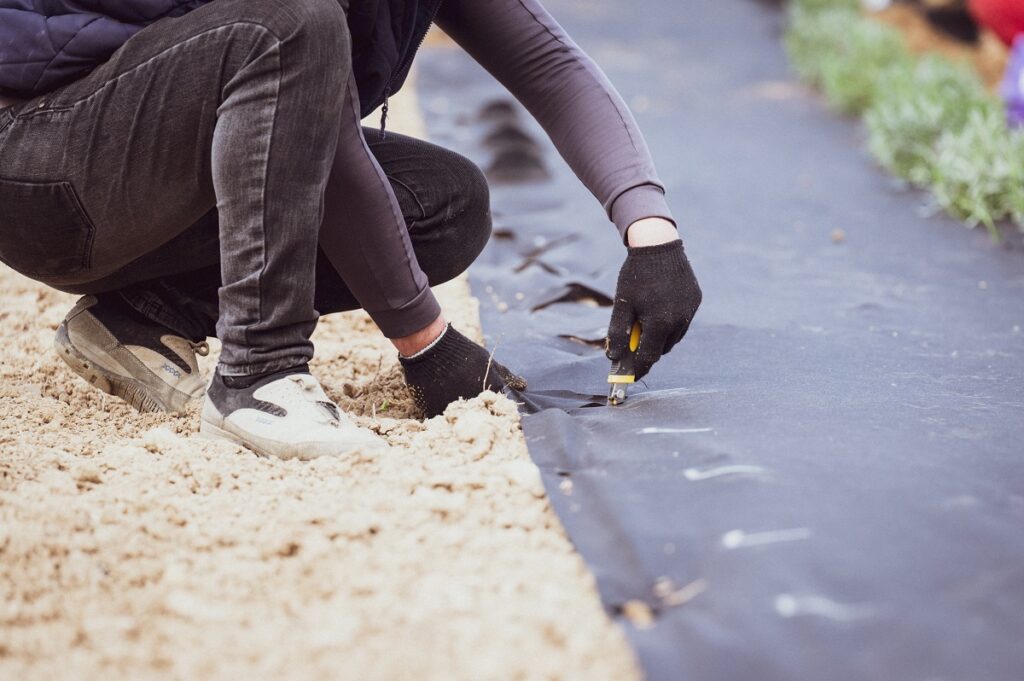
Can agro fleece be laid over weeds? Yes, agro-textile acts as an effective barrier against weeds, providing protection for crops. Its mechanism of action mainly consists in restricting the access of light to the soil layer, thus preventing the germination and growth of weeds. Thanks to its porous structure, this non-woven fabric is permeable to water and air, which promotes favourable conditions for the development of crops, while limiting the growth of weeds.
The use of agro-textiles has many benefits:
Agro-textile under weeds is therefore the absolute best solution for enjoying healthy and beautifully growing plants.
When the soil is properly prepared before applying the agro-textile under weeds, we can significantly increase its effectiveness. First of all, the area should be thoroughly cleared of any major weeds and their roots so that the agro-textile can perform its function effectively. The next step is to dig the soil about 15–20 cm deep to aerate the soil and remove smaller weeds. It is also a good idea to apply compost or organic fertilisers to improve the soil structure and provide essential nutrients to the plants.
The soil surface should then be levelled and tamped, providing a stable base for the agro-textile. Remember that well-prepared soil not only increases the effectiveness of the weed barrier, but also promotes healthy crop growth. It is only on soil prepared in this way that we can apply the agro-textile under weeds, making sure that it is well attached to the ground, which will prevent it from moving and new weeds from growing. It is worth investing in a weed fleece for the best results in the garden, eliminating the weed problem and minimising the need for regular weeding.
In order to properly apply the agro-textile under weeds, several steps must be followed to ensure maximum effectiveness and long-lasting protection against weeds. Once the soil has been thoroughly prepared, as described earlier, we proceed to spread the agro-textile. First, unroll the non-woven fabric over the designated area, making sure it covers the entire surface.
For larger areas, the agro-textile can be cut into suitable pieces, remembering to keep an overlap of about 10–15 cm to prevent weeds from overgrowing between the non-woven pieces.
Once the agro-textile under weeds is laid, it should be carefully fixed to the ground with special pegs or pins, which will prevent it from moving. It is important that the fixing is regular, especially at the edges and at the joining points. Next, a layer of bark, gravel or other mulching material can be applied to the surface of the fleece, which will further protect the fleece and improve the aesthetics of the garden. A properly applied agro-textile under weeds will effectively stop the growth of weeds, while at the same time allowing the crop to grow healthily. An agro-weed fleece is an excellent tool that will make tending your garden much easier and allow you to enjoy its beauty throughout the season.
Applying agro-textile under weeds can be highly effective, but common mistakes can reduce its effectiveness. One of the most common mistakes is not properly preparing the soil before applying the nonwoven fabric. Sometimes gardeners skip the thorough removal of larger weeds and their roots, which can lead to weeds growing through the agro-textile. Another common mistake is failing to maintain proper overlaps between pieces of non-woven fabric, allowing weeds to grow through the joints.
In order to avoid these problems, it is worth bearing in mind a few key principles:
By keeping these tips in mind, you will avoid the most common mistakes and maximise the potential of agro-textile under weeds, guaranteeing healthy plant growth without troublesome weeds. Can agro-fibre be laid over weeds? Yes, but proper soil preparation and precise placement of the nonwoven fabric is key.
Care and maintenance of the agro-weed fleece is crucial to ensure its long-term effectiveness. First of all, the condition of the nonwoven fabric should be monitored regularly, especially after heavy rainfall or strong winds. Make sure the non-woven fabric is still securely attached to the ground and, if necessary, improve the attachment with pegs or pins. Also remember to remove any debris, such as leaves or branches, that may accumulate on its surface. Regularly inspecting the jointing areas and correcting the 10–15 cm overlaps will keep the weed barrier continuous.
It is also a good idea to periodically check that plants are not overgrowing the fleece at the cuts made during planting. If you notice overgrown weeds, remove them manually so that they do not weaken the protection. The use of mulch, such as bark or gravel, on the surface of the non-woven fabric will not only improve the aesthetics of the garden, but will also further protect the agro-textile fabric. Regular care of these aspects will help to maintain the effectiveness and durability of the nonwoven fabric for many seasons. Want to find out more? Invest in a weed fleece and enjoy a beautifully maintained garden without troublesome weeds.